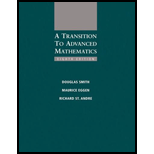
a.
Find the cardinality
a.
Answer to Problem 2E
Explanation of Solution
Given information:
Calculation:
Here we will consider the following set:
Now, suppose
As the number of elements in set
Thus, cardinality of
Now, define a function
Now, we prove that
Thus,
Now, to prove that
Let
Let
Thus, for
Thus,
Hence, there is one-to-one correspondence from set
b.
Find the cardinality
b.
Answer to Problem 2E
Explanation of Solution
Given information:
Calculation:
Here we will consider the following set:
Now, suppose
As,
Thus,
As the number of elements in set
Thus, cardinality of
Now, define a function
Now, we prove that
Thus,
Now, to prove that
Let
Let
Thus, for
Thus,
Hence, there is one-to-one correspondence from set
c.
Find the cardinality
c.
Answer to Problem 2E
Explanation of Solution
Given information:
Calculation:
Here we will consider the following set:
Now, suppose
As,
Thus,
As the number of elements in set
Thus, cardinality of
Now, define a function
Now, we prove that
Thus,
Now, to prove that
Let
Let
Thus, for
Thus,
Hence, there is one-to-one correspondence from set
d.
Find the cardinality
d.
Answer to Problem 2E
Explanation of Solution
Given information:
Calculation:
Here we will consider the following set:
Now, suppose
As,
Thus,
As the number of elements in set
Thus, cardinality of
Now, pairing of
Hence, this pattern defines one-to-one correspondence from set
Want to see more full solutions like this?
Chapter 5 Solutions
A Transition to Advanced Mathematics
- Page < 1 of 2 - ZOOM + 1) a) Find a matrix P such that PT AP orthogonally diagonalizes the following matrix A. = [{² 1] A = b) Verify that PT AP gives the correct diagonal form. 2 01 -2 3 2) Given the following matrices A = -1 0 1] an and B = 0 1 -3 2 find the following matrices: a) (AB) b) (BA)T 3) Find the inverse of the following matrix A using Gauss-Jordan elimination or adjoint of the matrix and check the correctness of your answer (Hint: AA¯¹ = I). [1 1 1 A = 3 5 4 L3 6 5 4) Solve the following system of linear equations using any one of Cramer's Rule, Gaussian Elimination, Gauss-Jordan Elimination or Inverse Matrix methods and check the correctness of your answer. 4x-y-z=1 2x + 2y + 3z = 10 5x-2y-2z = -1 5) a) Describe the zero vector and the additive inverse of a vector in the vector space, M3,3. b) Determine if the following set S is a subspace of M3,3 with the standard operations. Show all appropriate supporting work.arrow_forwardUsing Karnaugh maps and Gray coding, reduce the following circuit represented as a table and write the final circuit in simplest form (first in terms of number of gates then in terms of fan-in of those gates).arrow_forwardConsider the alphabet {a, b, c}.• Design a regular expression that recognizes all strings over {a, b, c} that have at least three nonconsec-utive c characters (two characters are non-consecutive if there is at least one character between them)and at least one a character.• Explain how your regular expression recognizes the string cbbcccac by clearly identifying which partsof the string match to the components of your regular expressionarrow_forward
- Complex Analysis 2 z3+3 Q1: Evaluate cz(z-i)² the Figure. First exam 2024-2025 dz, where C is the figure-eight contour shown inarrow_forwardConstruct a state-level description (i.e., a state diagram with transitions) for aTuring machine that decides the language {a^(n)b^(2n)c^(n) | n ∈ N}.arrow_forwardFind the sum of products expansion of the function F (x, y, z) = ̄x · y + x · z in two ways: (i) using a table; and (ii) using Boolean identitiesarrow_forward
- The NOR operator, denoted as ↓, behaves as 0 ↓ 0 = 1, 0 ↓ 1 = 0, 1 ↓ 0 = 0,1 ↓ 1 = 0. Show that the any Boolean function over any number of variables can be expressed using onlyNOR operators (in addition to those variables and constants). HINT: Recall that any Boolean function hasa representation as a sum of products expansionarrow_forwardConsider the Turing machine given in lecture which decides the languageB = {w#w | w is a binary string}.Simulate the Turing machine to show that the string 1001#1001 will be accepted by the Turing machine. Show all steps.arrow_forwardQ/Find the Laurent series of (2-3) cos↓ around z = 1. 2-1arrow_forward
- #1). A technique is given with 150 mAs is 40 kV and produces an EI value = 400. Find the new EI value, if mAs is 75 and 34 kV are used.arrow_forwardQ3: Answer the following: (i) Let f(z) is an analytic function in a simply connected domain S and y is a simple, closed, positively oriented contour lying in S. Prove that f, f(z)dz = 0.arrow_forwardUse the method of undetermined coefficients to solve the given nonhomogeneous system.X' = −1 33 −1 X + −4t2t + 2 X(t) =arrow_forward
 Algebra: Structure And Method, Book 1AlgebraISBN:9780395977224Author:Richard G. Brown, Mary P. Dolciani, Robert H. Sorgenfrey, William L. ColePublisher:McDougal Littell
Algebra: Structure And Method, Book 1AlgebraISBN:9780395977224Author:Richard G. Brown, Mary P. Dolciani, Robert H. Sorgenfrey, William L. ColePublisher:McDougal Littell Linear Algebra: A Modern IntroductionAlgebraISBN:9781285463247Author:David PoolePublisher:Cengage Learning
Linear Algebra: A Modern IntroductionAlgebraISBN:9781285463247Author:David PoolePublisher:Cengage Learning Elements Of Modern AlgebraAlgebraISBN:9781285463230Author:Gilbert, Linda, JimmiePublisher:Cengage Learning,
Elements Of Modern AlgebraAlgebraISBN:9781285463230Author:Gilbert, Linda, JimmiePublisher:Cengage Learning, Elementary Linear Algebra (MindTap Course List)AlgebraISBN:9781305658004Author:Ron LarsonPublisher:Cengage Learning
Elementary Linear Algebra (MindTap Course List)AlgebraISBN:9781305658004Author:Ron LarsonPublisher:Cengage Learning Algebra for College StudentsAlgebraISBN:9781285195780Author:Jerome E. Kaufmann, Karen L. SchwittersPublisher:Cengage Learning
Algebra for College StudentsAlgebraISBN:9781285195780Author:Jerome E. Kaufmann, Karen L. SchwittersPublisher:Cengage Learning




